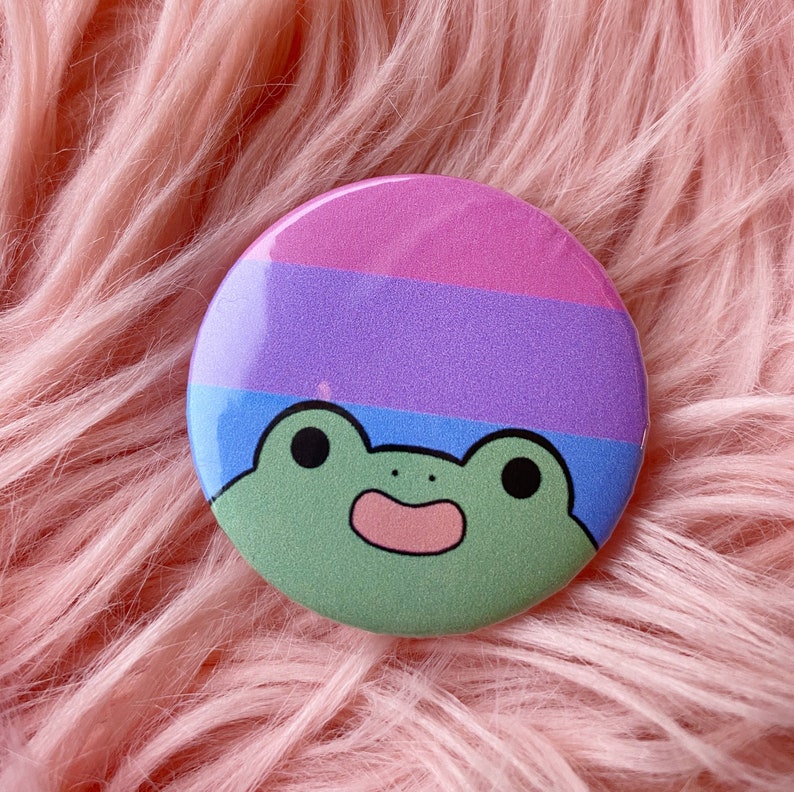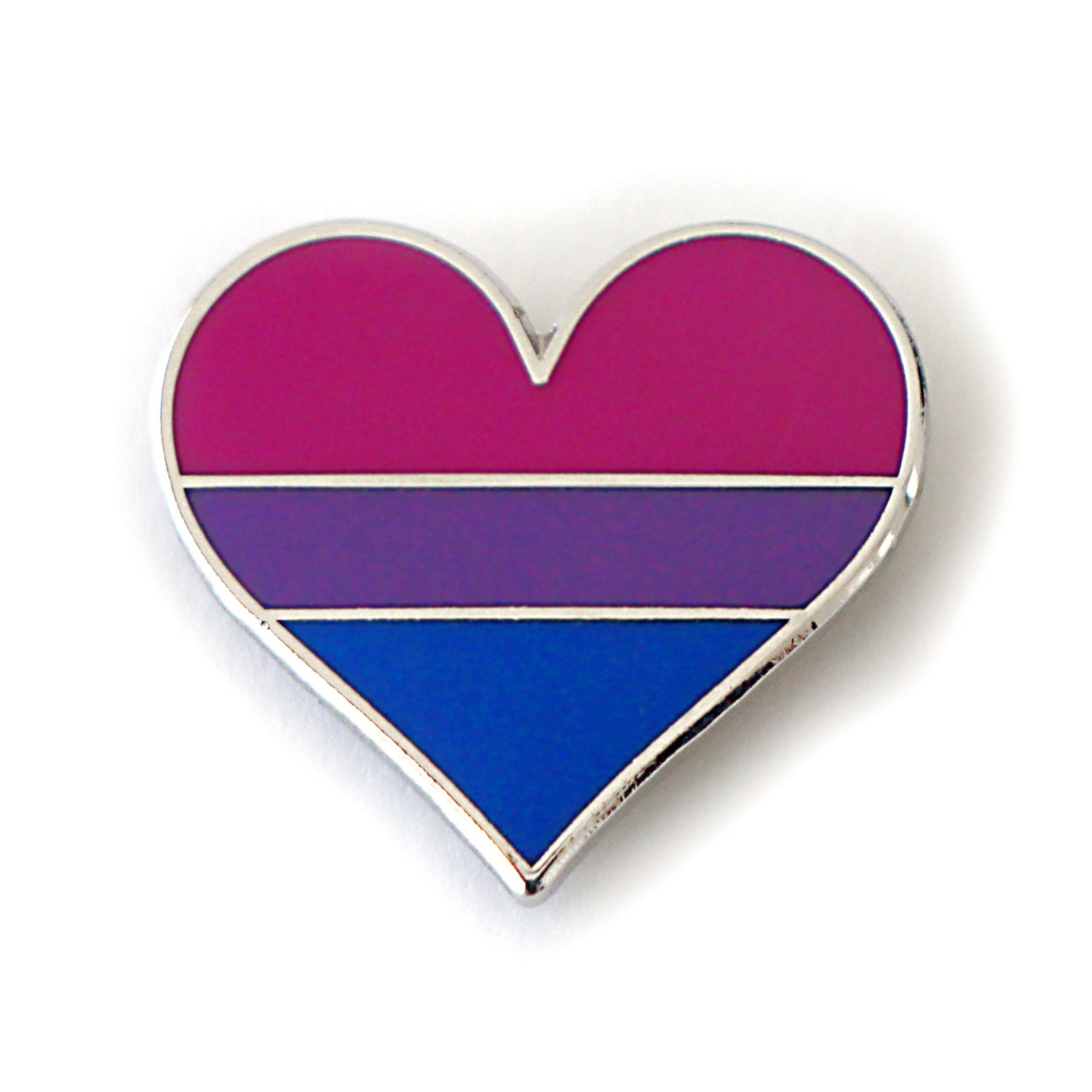In recent years, bisexual pins have become not only a symbol of pride and identity but also a fashion statement that resonates with many individuals across the globe. These small, yet significant, accessories carry the weight of inclusivity, representing a community often overshadowed in the broader LGBTQ+ spectrum. The role these pins play extends beyond mere aesthetics—they are emblems of acceptance, diversity, and unity.
Bisexual pins vary in design, from the classic bi pride flag colors of pink, purple, and blue, to more intricate designs that incorporate other symbols of bisexuality. These pins serve as a form of self-expression, allowing individuals to proudly showcase their identity. They also foster a sense of belonging, offering a visual cue to others that the wearer is part of the bisexual community or an ally.
Understanding the significance of bisexual pins requires a dive into their history, cultural impact, and the myriad ways they can be styled. As these pins become increasingly visible in society, they highlight the ongoing journey toward recognition and acceptance for bisexual individuals. This comprehensive guide will delve into the various aspects of bisexual pins, exploring their significance and the role they play in promoting awareness and understanding.
Table of Contents
- History of Bisexual Pins
- Symbolism and Meaning
- Design and Variations
- Cultural Impact
- How to Style Bisexual Pins
- Bisexual Pins in the Media
- Buying and Collecting
- Supporting LGBTQ+ Artists
- Bisexual Pins as Gifts
- The Future of Bisexual Pins
- Frequently Asked Questions
- Conclusion
History of Bisexual Pins
The history of bisexual pins is deeply intertwined with the broader history of LGBTQ+ activism. The bisexual pride flag, created by Michael Page in 1998, laid the foundation for the pins we see today. This flag was designed to increase the visibility and recognition of bisexual individuals, featuring the distinct colors of pink, purple, and blue to represent attraction to the same gender, attraction to both genders, and attraction to the opposite gender, respectively.
Initially, bisexual pins were primarily used within activist circles, serving as a way to identify and create solidarity among bisexual individuals. Over time, as the bisexual movement gained momentum and visibility, these pins began to surface in mainstream culture. The internet and social media platforms played significant roles in spreading awareness and promoting the use of bisexual pins as symbols of pride.
Today, bisexual pins are widely recognized and embraced not only by those who identify as bisexual but also by allies and supporters. This evolution reflects a broader societal shift towards inclusivity and acceptance of diverse identities, reinforcing the importance of these small, yet powerful, symbols.
Symbolism and Meaning
Bisexual pins carry profound symbolism and meaning, reflecting the unique experiences and struggles of bisexual individuals. The colors of the bisexual pride flag, often incorporated into pin designs, each hold specific meanings. Pink represents same-gender attraction, blue represents opposite-gender attraction, and purple, the blending of the two, signifies attraction to both or more than one gender.
The symbolism of bisexual pins extends beyond these colors, serving as a means of asserting one's identity in a world where bisexuality is often misunderstood or erased. These pins are a testament to the resilience and diversity within the bisexual community, providing a sense of visibility and validation.
Moreover, bisexual pins can signify solidarity and allyship, with many non-bisexual individuals wearing them to show support for the community. This act of wearing a pin transcends personal identity, fostering a culture of acceptance and understanding across different sexual orientations.
Design and Variations
The design of bisexual pins is as varied as the individuals who wear them. While some prefer the simplicity of the traditional pride flag colors, others opt for more creative designs that incorporate additional symbols or messages. Common variations include heart shapes, infinity symbols, and phrases that promote bisexual pride and visibility.
Many artists and creators have embraced the challenge of designing bisexual pins that are not only aesthetically pleasing but also meaningful. These designs often incorporate elements of art and culture, reflecting the diverse backgrounds and experiences of those within the bisexual community.
As bisexual pins gain popularity, new designs continue to emerge, offering individuals countless options to express their identity and support for the bisexual community. This diversity in design highlights the inclusivity and creativity inherent in the bisexual movement.
Cultural Impact
The cultural impact of bisexual pins cannot be overstated. These small symbols have played a significant role in increasing visibility and awareness of bisexuality, challenging stereotypes and misconceptions. By wearing these pins, individuals contribute to a broader dialogue about the complexity and diversity of human sexuality.
Bisexual pins have also become a form of activism, used in protests, parades, and other public events to advocate for bisexual rights and recognition. Their presence in these spaces highlights the ongoing struggle for equality and acceptance within the LGBTQ+ community.
Moreover, bisexual pins have influenced fashion and popular culture, appearing in films, television shows, and on social media platforms. This visibility helps normalize bisexuality, making it more accessible and understandable to the general public.
How to Style Bisexual Pins
Styling bisexual pins offers a unique opportunity to express one's identity creatively. These pins can be worn on clothing, bags, hats, or even incorporated into jewelry, allowing for a versatile and personalized fashion statement. The key to styling bisexual pins is to let them complement one's personal style while making a bold statement.
For those new to wearing pins, starting with a single, prominent pin can be an effective way to showcase bisexual pride. As comfort and confidence grow, additional pins can be added to create a more personalized and layered look. Pairing pins with complementary colors or patterns can enhance their visual impact.
Ultimately, styling bisexual pins is about embracing individuality and celebrating diversity. Whether worn subtly or boldly, these pins serve as powerful reminders of one's identity and the community they represent.
Bisexual Pins in the Media
The portrayal of bisexual pins in the media has helped raise awareness and promote acceptance of bisexuality. Characters in popular television shows and films have been depicted wearing these pins, highlighting their significance as symbols of bisexual pride. This representation contributes to the normalization of bisexuality, challenging stereotypes and fostering a more inclusive media landscape.
Social media platforms have also played a crucial role in promoting bisexual pins. Influencers and celebrities often share their experiences and support for the bisexual community by showcasing these pins in photos and videos. This visibility helps create a sense of community and solidarity among bisexual individuals and their allies.
As bisexual pins continue to gain media attention, they serve as powerful tools for advocacy and education, encouraging open conversations about bisexuality and its unique challenges.
Buying and Collecting
For many, buying and collecting bisexual pins is more than just a hobby; it's a way of supporting the bisexual community and expressing solidarity. There are numerous online and brick-and-mortar stores that offer a wide variety of designs, catering to different tastes and preferences.
When purchasing bisexual pins, it's important to consider supporting LGBTQ+ artists and creators. Many independent artists sell their designs online, offering unique and handmade pins that reflect the diversity and creativity of the bisexual community. Supporting these artists not only helps promote their work but also contributes to a more inclusive and equitable marketplace.
Collecting bisexual pins can also be a way of commemorating important events or milestones within the LGBTQ+ movement. Many pins are designed to celebrate specific pride events or anniversaries, serving as tangible reminders of the progress made toward equality and acceptance.
Supporting LGBTQ+ Artists
Supporting LGBTQ+ artists is a meaningful way to promote diversity and inclusivity within the art and design community. Many artists draw inspiration from their own experiences and identities, creating bisexual pins that resonate with individuals across the globe.
Purchasing bisexual pins from LGBTQ+ artists helps ensure that these creators can continue to produce meaningful and impactful work. It also supports the broader LGBTQ+ community by fostering an environment where diverse voices and perspectives are celebrated and valued.
Moreover, supporting LGBTQ+ artists can lead to the discovery of unique and innovative designs that reflect the dynamic and evolving nature of bisexual culture. By investing in these artists, individuals contribute to the growth and visibility of the bisexual movement.
Bisexual Pins as Gifts
Bisexual pins make thoughtful and meaningful gifts for friends, family, or partners who identify as bisexual or support the community. These pins offer a way to show appreciation and solidarity, serving as a tangible reminder of one's support and understanding.
When selecting bisexual pins as gifts, consider the recipient's personal style and preferences. Opt for designs that reflect their unique identity or interests, ensuring that the gift is both meaningful and personal.
Additionally, gifting bisexual pins can help raise awareness and promote conversations about bisexuality, contributing to a more inclusive and understanding environment. Whether given as a birthday present, holiday gift, or token of appreciation, bisexual pins offer a heartfelt way to celebrate and honor the bisexual community.
The Future of Bisexual Pins
The future of bisexual pins is bright, with continued growth and innovation on the horizon. As society becomes more accepting and inclusive, the demand for bisexual pins and other symbols of pride is likely to increase. This growth presents opportunities for artists and creators to explore new designs and concepts, pushing the boundaries of what bisexual pins can represent.
Technological advancements and social media platforms will also play a significant role in shaping the future of bisexual pins. These tools offer new ways to connect with audiences, share designs, and promote the bisexual movement. As visibility and awareness increase, bisexual pins will continue to serve as powerful symbols of identity, pride, and community.
Ultimately, the future of bisexual pins lies in the hands of those who wear and support them. By embracing these symbols and advocating for visibility and acceptance, individuals can help shape a more inclusive and understanding world.
Frequently Asked Questions
What do the colors on bisexual pins represent?
The colors on bisexual pins typically represent the bisexual pride flag: pink for same-gender attraction, blue for opposite-gender attraction, and purple for attraction to more than one gender.
Where can I buy bisexual pins?
Bisexual pins can be purchased online from various retailers, including those who support LGBTQ+ artists. They are also available at some local pride events and LGBTQ+ community centers.
Are bisexual pins only for bisexual individuals?
No, bisexual pins can be worn by anyone, including allies who wish to show support for the bisexual community and promote inclusivity.
How can I style bisexual pins?
Bisexual pins can be styled by wearing them on clothing, bags, hats, or as part of jewelry. They can be worn alone or in combination with other pins to create a personalized look.
Why are bisexual pins important?
Bisexual pins are important because they promote visibility, awareness, and acceptance of bisexuality. They serve as symbols of pride, identity, and solidarity within the LGBTQ+ community.
How can I support LGBTQ+ artists who create bisexual pins?
You can support LGBTQ+ artists by purchasing their designs, sharing their work on social media, and promoting their contributions to the art and design community.
Conclusion
Bisexual pins are more than just accessories; they are powerful symbols of pride, identity, and community. They represent the resilience and diversity within the bisexual movement, offering a means of self-expression and advocacy for individuals across the globe. As society continues to progress towards inclusivity and acceptance, bisexual pins will remain important tools for promoting visibility and understanding. By embracing these symbols and supporting the artists who create them, we can help foster a more inclusive and equitable world for all.
Learn more about bisexuality and how to support the community.

